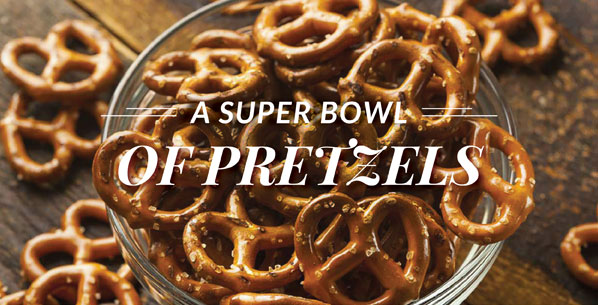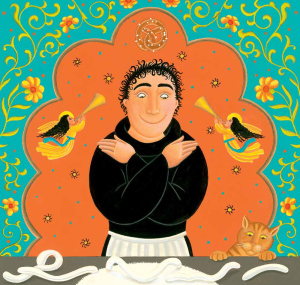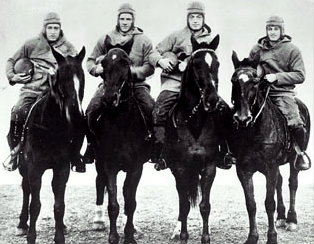
A long time ago in a place far away…
A common origin story of pretzels is that they were created by a monk around 610 in Italy. The monk baked strips of dough that he folded into a shape resembling a child crossing its arms in prayer. He would give these treats, which he called "pretiolas" or "little rewards," to children who had memorized their prayers. Other similar stories star a monk from France and bakers held hostage in Germany, and some refer to pretzels as "angel wings."
"Good luck snacks"
In a prayer book used by Catherine of Cleves in 1440, there was a picture of Saint Bartholomew surrounded by pretzels. By this time, pretzels were considered a sign of good luck and spiritual wholeness—possibly due to the three holes in the common pretzel shape touted to represent the Holy Trinity at this point.  The "good luck" connotation carried the pretzel to other holidays, including New Year's Day, when in Germany children hung pretzels around their necks; pretzels hung on Christmas trees in Austria in the 16th century; and parents hid little pretzels on Easter for children to find, an early version of an Easter egg hunt. In Switzerland, the pretzel shape was used as a marriage knot, and couples would each pull on a side of the pretzel on their wedding day. The larger half brought prosperity to the marriage—it was kind of like a doughy wishbone tradition.
The "good luck" connotation carried the pretzel to other holidays, including New Year's Day, when in Germany children hung pretzels around their necks; pretzels hung on Christmas trees in Austria in the 16th century; and parents hid little pretzels on Easter for children to find, an early version of an Easter egg hunt. In Switzerland, the pretzel shape was used as a marriage knot, and couples would each pull on a side of the pretzel on their wedding day. The larger half brought prosperity to the marriage—it was kind of like a doughy wishbone tradition.
Stock up for Lent now
Pretzels have long been integrated into the Christian faith. By the 16th century, it had become tradition to eat pretzels on Good Friday in Germany, and Catholics once considered them the "official food of lent." Earlier laws of the Church stated that only one meal a day was to be eaten during Lent and the food couldn't come from an animal. Yet another origin story says that pretzels were developed as a food for lent. Whether or not this is true, pretzels did become a popular staple during the holiday because it was easy to make and fulfilled the Church's guidelines.
Is the City of Brotherly Love really the City of "Angels"?
Pretzels made their way across the Atlantic with German immigrants who were later to be known as the Pennsylvania Dutch in the 1700s. Many pretzel bakeries popped up in Pennsylvania around this time, and Pennsylvania continued to be the seat of American pretzel production and consumption; around 80% of pretzels made in America are made in Pennsylvania today. While it's estimated that Americans eat two pounds of pretzels in a year, pretzel consumption in Philadelphia is estimated to be around twelve pounds of pretzels per person per year.
—————— We're going long… ——————
The story of the first
Hail Mary pass
Jim Crowley, one of the Notre Dame coach Knute Rockne's famous team titled "Four Horseman," often told the story of an October 28, 1922, game between Notre Dame and Georgia Tech in which the Fighting Irish players said Hail Mary prayers together before scoring each of the touchdowns, winning the game 13 to 3. According to Crowley, it was one of the team's linemen, Noble Kizer, who suggested praying before the first touchdown. Quarterback Harry Stuhldreher, another of the Horsemen, threw a quick pass over the middle to another player for the score. The ritual was repeated again in the fourth quarter. This time Stuhldreher ran for a touchdown, which sealed the win for Notre Dame. After the game, Kizer exclaimed to Crowley, "Say, that Hail Mary is the best play we've got." Crowley related this story many times in public speeches beginning in the 1930s.

The Four Horsemen of Notre Dame